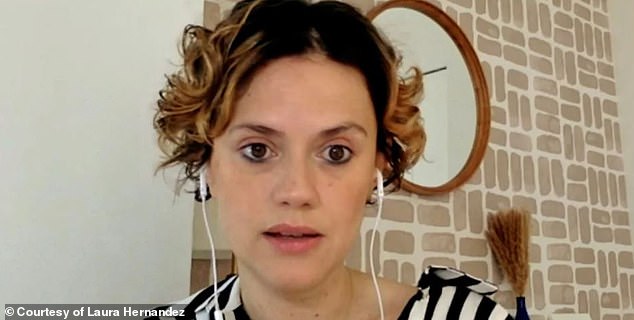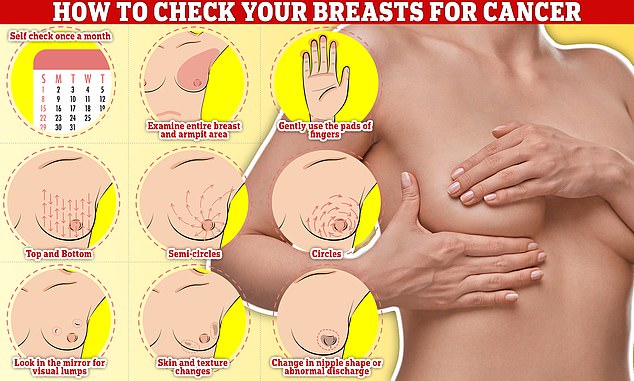Two women in their 30s were diagnosed with breast cancer after being told their symptoms were ‘nothing’ – a tragic story that is becoming increasingly common in the US.
Laura Hernandez, a 39-year-old journalist in New York City, quickly sought help from her gynecologist when she felt a small lump under her left armpit.
However, her doctor assured her it was ‘nothing’ due to her age, but ordered a mammogram to be sure. The results came back as breast cancer, which affects more than 300,000 American women every year.
Julieta Cruz, 36, a hair and makeup artist in Florida, was feeding her baby when she felt a “bulge” in her breast.
Her doctor insisted it was due to hormones or pent-up milk, so Ms. Cruz requested a mammogram over the next three months.
A specialist said it was a cyst or fibrosis – thickened or scarred tissue – and a genetic test came back negative for cancer risk.
Julieta Cruz, 36, had to pretend to be in severe pain to get examined after three months of asking doctors to perform a mammography
Laura Hernandez, 39, was told her cancer was “nothing” because she was young and healthy
After another three weeks, she pretended to be in severe pain so she could take another exam. A biopsy confirmed stage 1 breast cancer.
“This happens to all of us, it happens to us when we are very young, and it happens to Latinas,” Ms. Hernandez told the Spanish-language site. Noticias Telemundo.
Breast cancer is the most common form of cancer in both the US and the world. The National Cancer Institute (NCI) estimates there will be more than 300,000 new cases this year, along with 43,700 deaths.
According to the American Cancer Society, the average age at which women are diagnosed with breast cancer is 62. For Latinas it is 57 years.
“A very small number of women diagnosed with breast cancer are under the age of 45,” the agency said.
Mortality rates fell by 43 percent between 1989 and 2020, following successful public health awareness campaigns, better screening and new medications.
Today, nine out of ten patients are expected to survive after five years.
In May, a leading health panel recommended lowering the age at which women undergo regular breast examinations from 50 to 40, while the number of younger people developing the disease is increasing.
In August, a study found that certain types of cancer, including breast cancer, are diagnosed more often in young people, especially young women in their 30s.
Checking your breasts should be part of your monthly routine so that you notice any unusual changes. Simply rub and feel from top to bottom, feeling in semi-circles and in a circular motion around your breast tissue to feel for any abnormalities
The U.S. Preventive Services Task Force (USPSTF) said that 20 million women in their 40s would benefit from a mammogram every two years.
Currently, all women aged 50 to 74 are advised to have a mammogram, an energy-efficient x-ray of their breasts, checked every two years.
Ms. Hernandez underwent a lumpectomy, which removed the cancer and abnormal tissues. Her cancer is now in remission.
Ms. Cruz underwent a double mastectomy, a procedure in which both breasts are completely removed, to “eliminate the problem at its root.”
The hair and make-up artist also lost her hair, eyebrows and eyelashes due to treatments.
‘To suddenly lose that and look in the mirror and not recognize yourself, that’s difficult, isn’t it?’ she told Noticias Telemundo.
‘You have to start from within.’
Ms. Cruz shows no signs of cancer, although she will have blood tests every six months and will be on maintenance medications for 10 years.
Breast cancer is one of the most common cancers in the world, affecting more than two MILLION women every year
Breast cancer is one of the most common forms of cancer in the world. There are more than 55,000 new cases in Britain every year, and the disease claims the lives of 11,500 women. In the US it affects 266,000 people and kills 40,000 every year. But what causes it and how can it be treated?
What is breast cancer?
It comes from a cancer cell that develops in the lining of a duct or lobe in one of the breasts.
When the breast cancer has spread to surrounding tissue, it is called ‘invasive’. Some people are diagnosed with ‘carcinoma in situ’, where no cancer cells have grown outside the duct or lobule.
Most cases develop in people over the age of 50, but sometimes younger women are also affected. Breast cancer can develop in men, although this is rare.
Staging indicates how big the cancer is and whether it has spread. Stage 1 is the earliest stage and stage 4 means the cancer has spread to another part of the body.
The cancer cells are classified from low, which means slow growth, to high, which means fast growth. High-grade cancers are more likely to come back after they are first treated.
What causes breast cancer?
A cancerous tumor starts from one abnormal cell. The exact reason why a cell becomes cancerous is unclear. It is thought that something damages or changes certain genes in the cell. This causes the cell to become abnormal and multiply ‘out of control’.
Although breast cancer can develop for no apparent reason, there are some risk factors that can increase its likelihood, such as genetics.
What are the symptoms of breast cancer?
The usual first symptom is a painless lump in the breast, although most are not cancerous and are fluid-filled cysts, which are benign.
The first place breast cancer usually spreads to is the lymph nodes in the armpit. When this happens, a swelling or lump develops in the armpit.
How is breast cancer diagnosed?
- Initial assessment: A doctor examines the breasts and armpits. They may do tests such as a mammogram, a special X-ray of the breast tissue that can indicate the possibility of tumors.
- Biopsy: A biopsy involves removing a small piece of tissue from a part of the body. The sample is then examined under a microscope to look for abnormal cells. The sample can confirm or rule out cancer.
If you are confirmed to have breast cancer, further tests may be needed to assess whether the cancer has spread. For example, blood tests, an ultrasound of the liver or an X-ray of the chest.
How is breast cancer treated?
Treatment options that may be considered include surgery, chemotherapy, radiotherapy and hormone treatment. A combination of two or more of these treatments is often used.
- Surgery: Breast-conserving surgery or removal of the affected breast, depending on the size of the tumor.
- Radiotherapy: A treatment that uses high-energy beams of radiation aimed at cancerous tissue. This kills cancer cells or prevents them from multiplying. It is mainly used as an adjunct to surgery.
- Chemotherapy: A cancer treatment that uses anticancer drugs that kill cancer cells or prevent them from multiplying.
- Hormone treatments: Some types of breast cancer are affected by the ‘female’ hormone estrogen, which can stimulate cancer cells to divide and multiply. Treatments that lower the levels of these hormones or prevent them from working are often used in people with breast cancer.
How successful is the treatment?
The outlook is best in those who are diagnosed when the cancer is still small and has not spread. Surgical removal of a tumor at an early stage can then give a good chance of cure.
Thanks to routine mammography offered to women between the ages of 50 and 70, more cases of early-stage breast cancer are being diagnosed and treated.
For more information, visit breastcancernow.org or call the free helpline on 0808 800 6000



